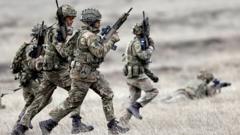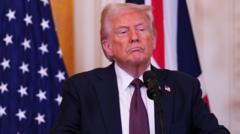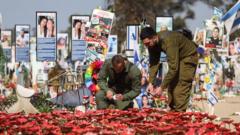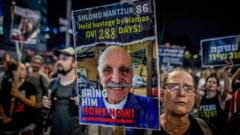In the final moments before a significant announcement, details emerge on how a blend of diplomatic strategy and timing led to a breakthrough amid complex geopolitical tensions.
**Historic Ceasefire Negotiations Conclude with Dramatic Last-Minute Agreement**

**Historic Ceasefire Negotiations Conclude with Dramatic Last-Minute Agreement**
An intricate mosaic of diplomacy unfolded as negotiators finalize a ceasefire between Israel and Hamas under intense time pressure.
The ceasefire negotiations between Israel and Hamas reached a dramatic conclusion just minutes before a planned press conference, demonstrating the precarious nature of Middle Eastern diplomacy. As the world awaited news in Doha, negotiators from each side remained physically separated by one floor yet were intensely engaged through intermediaries from Qatar, Egypt, and the U.S. The late-stage discussions, filled with urgency, required quick adjustments and compromises, with sources revealing that negotiations continued right up until just 10 minutes prior to the anticipated announcement.
The framework for the ceasefire, officially established on January 15, mirrored earlier proposals, particularly one revealed by President Joe Biden in May, which enabled a three-part strategy. The agreement outlines a ceasefire, the release of Israeli hostages alongside Palestinian prisoners, and a gradual withdrawal of Israeli troops from Gaza. This outcome wasn't unexpected, as by mid-December, the dynamics of the discussions had shifted significantly, driven by Hamas's declining position following military losses and international pressure.
A senior Biden administration official noted that Hamas began to realize it could no longer rely on outside intervention to stabilize its situation and was forced to reconsider its negotiating stance. The Israeli perspective reflected similar frustrations, with officials asserting that Hamas had initially been more in control but that pivoting circumstances led to a more urgent need for an agreement.
Key moments of negotiation included a crucial meeting between Biden's team and Israeli Prime Minister Benjamin Netanyahu on December 12, where discussions revolved around regional influences and how to capitalize on the recent ceasefire in Lebanon to facilitate deeper negotiations over Gaza. Additionally, with Donald Trump's imminent presidency on the horizon, there was new energy surrounding the negotiations—Hamas officials expressed cautious optimism that the incoming administration might aid in accelerating the agreement.
Despite initial hurdles in December, the involvement of Qatari and Egyptian mediators, coupled with a clear mandate from the U.S. administration, helped reach critical milestones. Tensions flared as negotiators faced disagreements about the conditions for hostages' releases and the precise lists of prisoners involved, yet these challenges gradually yielded to the pressures for resolution.
Throughout January, negotiations transformed into "proximity talks" wherein representatives from both factions occupied separate floors in a Doha building, with mediators exchanging crucial documentation. Behind-the-scenes, U.S. envoys intensified their roles, particularly with Steve Witkoff's arrival to support the discussions.
As the clock wound down to the expected announcement, lingering issues related to the mechanisms for civilian return and search protocols for displaced individuals from Gaza generated delays. Yet as the negotiators drew closer to finalizing terms, momentum surged, underscoring the critical, albeit uncertain, pathway to peace.
The culmination of weeks of intense discussions provided a newfound hope as the ceasefire was proclaimed effective, promising sorely needed relief to countless families affected by the conflict. The complexities of the negotiations serve as a testament to the fragile nature of peace in a historically volatile region, revealing that even the most strained negotiations can yield a glimmer of optimism when resolved through extraordinary efforts and diplomatic finesse.
The framework for the ceasefire, officially established on January 15, mirrored earlier proposals, particularly one revealed by President Joe Biden in May, which enabled a three-part strategy. The agreement outlines a ceasefire, the release of Israeli hostages alongside Palestinian prisoners, and a gradual withdrawal of Israeli troops from Gaza. This outcome wasn't unexpected, as by mid-December, the dynamics of the discussions had shifted significantly, driven by Hamas's declining position following military losses and international pressure.
A senior Biden administration official noted that Hamas began to realize it could no longer rely on outside intervention to stabilize its situation and was forced to reconsider its negotiating stance. The Israeli perspective reflected similar frustrations, with officials asserting that Hamas had initially been more in control but that pivoting circumstances led to a more urgent need for an agreement.
Key moments of negotiation included a crucial meeting between Biden's team and Israeli Prime Minister Benjamin Netanyahu on December 12, where discussions revolved around regional influences and how to capitalize on the recent ceasefire in Lebanon to facilitate deeper negotiations over Gaza. Additionally, with Donald Trump's imminent presidency on the horizon, there was new energy surrounding the negotiations—Hamas officials expressed cautious optimism that the incoming administration might aid in accelerating the agreement.
Despite initial hurdles in December, the involvement of Qatari and Egyptian mediators, coupled with a clear mandate from the U.S. administration, helped reach critical milestones. Tensions flared as negotiators faced disagreements about the conditions for hostages' releases and the precise lists of prisoners involved, yet these challenges gradually yielded to the pressures for resolution.
Throughout January, negotiations transformed into "proximity talks" wherein representatives from both factions occupied separate floors in a Doha building, with mediators exchanging crucial documentation. Behind-the-scenes, U.S. envoys intensified their roles, particularly with Steve Witkoff's arrival to support the discussions.
As the clock wound down to the expected announcement, lingering issues related to the mechanisms for civilian return and search protocols for displaced individuals from Gaza generated delays. Yet as the negotiators drew closer to finalizing terms, momentum surged, underscoring the critical, albeit uncertain, pathway to peace.
The culmination of weeks of intense discussions provided a newfound hope as the ceasefire was proclaimed effective, promising sorely needed relief to countless families affected by the conflict. The complexities of the negotiations serve as a testament to the fragile nature of peace in a historically volatile region, revealing that even the most strained negotiations can yield a glimmer of optimism when resolved through extraordinary efforts and diplomatic finesse.






















